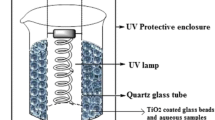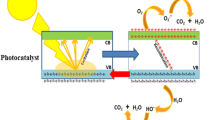Abstract
Method for production of photocatalysts based on zinc oxide deposited to glass fibrous woven material is discussed. The process of destruction of volatile organic compounds acetone in gaseous phase with application of the developed photocatalytic material was investigated.
Similar content being viewed by others
References
Acetone. Record У41. Hazardous Substances Data Base, National Library of Medicine: USA National Institute of Health, 2004. http://toxnet.nlm.nih.gov.
Herrmann, J.M., in Proc. Symp. Excited State Catalysis, Limerick, 2001, p. 3.
Savinov, E.N., Soros Educat. J., 2000, vol. 6, no. 11, p. 52.
Handbook on Advanced Photochemical Oxidation Processes, Cincinnati: US EPA Center for Environmental Research Information, 1998.
Henschel, B., Inside IAQ. EPA’s Indoor Air Quality Research Update, Cincinnati: US EPA Center for Environmental Research Information, 1996.
Blake, D.M., in Bibliography of work on the photocatalytic removal of hazardous compounds from water and air (with updates У1–3), NREL, Golden, 1994–1999.
Tseng, J. and Huang, C.P., in Mechanistic aspects of the photocatalytic oxidation of phenol in aqueous solutions. Emerging technologies in hazardous waste management. Chapter 2, Washington: American Chemical Society, D.C., 1990, pp. 1–39.
Spitskiy, S.V., Autoref. diss. cand. tech. sci., Sankt-Peterburg: SPGUTD, 2003.
Yamazoe, S., Okumura, T., Teramura, K., and Tanaka, T., Catal. Today, 2006, no. 111, p. 266.
Galvez, J.B. and Rodriguez, S.M., in Solar Detoxification. Part of the World Solar Programme 1996–2005. UNESCO, 2001.
Encyclopedia of catalysis. Vol. 5, New York: Wiley-Interscience: John Wiley & Sons, Inc., Publ., 2003.
Pirkanniemi, K. and Sillanpaa, M., Chemosphere, 2002. vol. 48, p. 1047.
Vorontzov, A.V., Barannik, G.B., Snegurenko, O.I., Savinov, E.N., and Parmon, V.N., Kinetika i Kataliz (Kinetics and Catalysis), 1997, vol. 38, no. 1, p. 97.
Goswami, J., Triverdi, D., and Block, S., Solar Engineering, 1995, vol. 1, ASME 95, p. 421.
Author information
Authors and Affiliations
Additional information
Original Russian Text © S.V. Spitskiy, A.D Parshina, 2010, published in Ekologicheskaya Khimiya, 2010, Vol. 19, No. 4, pp. 205–210.
Sergey Viktorovich Spitskiy, Cand. Sci. (Techn.), Assistant Professor, Department of Engineering Chemistry and Industrial Ecology, Saint-Petersburg State University of Technology and Design. Scientific areas of locus: detoxification of waste water and gaseous emissions, photochemistry, photocatalysis, ecotoxicology, environmental management.
Alexandra Dmitrievna Parshina, post-graduate student, Department of Engineering Chemistry and Industrial Ecology, Saint-Petersburg State University of Technology and Design. Scientifi c areas of locus: detoxifi cation of gaseous emissions, photocatalysis.
Rights and permissions
About this article
Cite this article
Spitskiy, S.V., Parshina, A.D. Zinc oxide-based photocatalyst on woven fiberglass support for destruction of volatile organic compounds in air. Russ J Gen Chem 80, 2762–2767 (2010). https://doi.org/10.1134/S1070363210130098
Received:
Published:
Issue Date:
DOI: https://doi.org/10.1134/S1070363210130098




